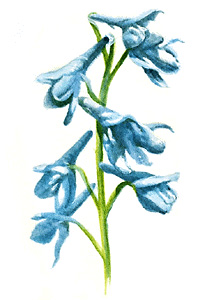Larkspur is a group of flowering plants that grow in cool regions. The name comes from a curved, spurlike growth on the petallike base of each flower. The leaves are finely divided, the lobes spreading like fingers on a hand.

There are hundreds of larkspurs. The smallest kinds are about 1 foot (30 centimeters) tall, and the larger may grow 7 feet (2.1 meters) tall. Colors range from blue or white to pink or reddish-purple. Some larkspurs can poison cattle. Cases of larkspur poisoning have occurred on Western ranges. Sheep are almost immune to the poison, and horses are only slightly affected. A European larkspur has been used in medicine.
Many kinds of larkspurs are grown as ornamental plants. Most grow easily because they do not require any special care. They do best in the open, in rich soil. Most larkspurs are planted from seed in the autumn or early spring, and flower in summer. They grow from an underground stem called a rhizome (see Rhizome ). New plants may be grown from divisions of the rhizome, or from cuttings made from young shoots in spring.
Larkspurs may become infected with a fungus disease called sclerotium rot, which yellows the leaves and wilts the plant. The disease can be controlled by removing the infected plant and by replacing the earth within a 11/2-foot (46-centimeter) radius. Larkspurs also can be infected by mildew.
